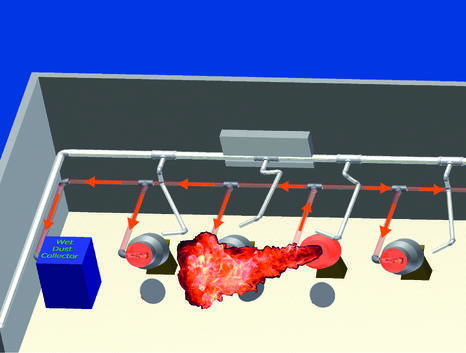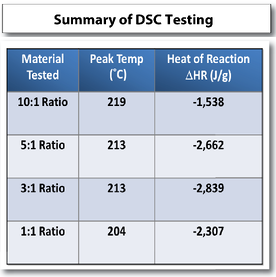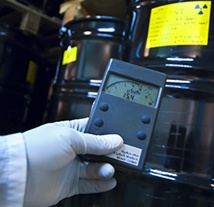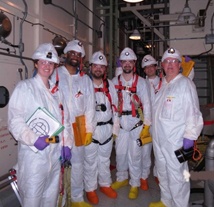 A deflagration incident (explosion) occurred during the cleaning procedure of a pan coater that was used in an encapsulation process where a latex coating was spray-applied intermittently to small beads of an oxidizing chemical. This case study describes the incident, and investigation including reviewing testing results, providing process hazard evaluation (PHA) and outlining benefits of process safety management (PSM) systems and best practices for fire and explosion protection due to combustible dust.
A deflagration incident (explosion) occurred during the cleaning procedure of a pan coater that was used in an encapsulation process where a latex coating was spray-applied intermittently to small beads of an oxidizing chemical. This case study describes the incident, and investigation including reviewing testing results, providing process hazard evaluation (PHA) and outlining benefits of process safety management (PSM) systems and best practices for fire and explosion protection due to combustible dust.
Incident Description
The company employed four pan coaters in series. Each had an exhaust tube connected to a common duct leading to a wet dust collector as well as an air connection utilizing a common air supply. On the day of the incident, two of the four pan coaters required cleaning due to a layer of latex and chemical that adhered to the inside of the pan. The cleaning process presented a challenge since the pan geometry made it difficult to clean, and the well-cured coating adhering to the pan proved stubbornly resistant to scraping, chipping and other physical means of attack.
In frustration at the difficulty of removing the residual coating, an employee began to chisel at it forcefully with a large and heavy steel pry bar. The repeated blows from the pry bar caused a roughly 2 inch diameter area on the exterior of the pan to glow red from heat. Two employees then observed the red spot rapidly grow to approximately 6 to 8 inches in size. At this time, they chose to evacuate the room. Approximately 20 seconds later an explosion occurred.
There was no explosion isolation in place between the pan coaters to prevent deflagration propagation between the interconnected pieces of equipment. Such isolation is recommended by NFPA 654, Standard for the Prevention of Fire and Dust Explosions from the Manufacturing, Processing, and Handling of Combustible Particulate Solids. As a result the deflagration pressure wave and fire generated from the incident spread out of the pan coater mouth and through the exhaust ductwork to the other interconnected coaters. Due to overpressure, the exhaust system ductwork ruptured. Residual coating material in the other dirty pan coaters also ignited. Thankfully, no personnel were injured.
Incident Testing Results
In an effort to characterize the events that led to the incident, several Differential Scanning Calorimetry (DSC) tests were performed using several ratios of coating to oxidizer material. The most energetic sample was then tested in various forms for drop weight impact (BAM Fallhammer) testing. It should be noted that samples 3 and 6 were wet material.
_chart.png?width=285&name=drop_impact_testing_(2)_chart.png)

Integrated Solution
Though this process was not covered by OSHA Process Safety Management (PSM), several elements of PSM were utilized to reduce risk, improve methods, review management systems and ensure that personnel were aware of critical tasks.
Incident Investigation
- Root cause analysis identified impact sensitivity, lack of appropriate procedures and inappropriate cleaning tools
Process Safety Information (PSI)
- Thermal stability and impact sensitivity were not known
- Cleaning procedures were not available/reviewed during the PHA
Process Hazard Analysis (PHA)
- PHA was performed, however PSI was not complete
- Appropriate personnel were not involved
- Change in raw material was not considered regarding the impact on the process
Mechanical Integrity (MI)
- Usage and wear of equipment was reviewed to determine appropriate maintenance and replacement schedules
- Reviewed MI program with employees to define expectations and unacceptable repair methods
Procedures
- Job Hazard Analyses (JHAs) were conducted with employees to identify hazards associated with operations cleaning and maintenance tasks associated with equipment used for this process
Training
- Operators were trained regarding updated procedures, as well as the functionality of the MI and Management of Change (MOC) programs and how to access these programs
Facility Siting & Human Factors
- New production facility was designed incorporating industry best practices
Conclusion
Updated process safety information was used to reduce risks associated with this process:
-
Several alternative cleaning strategies were investigated and a non-impact method was selected.
-
Spray methodology was changed to reduce the accumulation of coating on the inside wall of the pan coaters by improving the angle of the spray and reducing the timing of the spray.
-
Employee involvement in the review of procedures was critical to understand current practices, evaluate potential alternatives and obtain employee support for the procedure changes that followed










